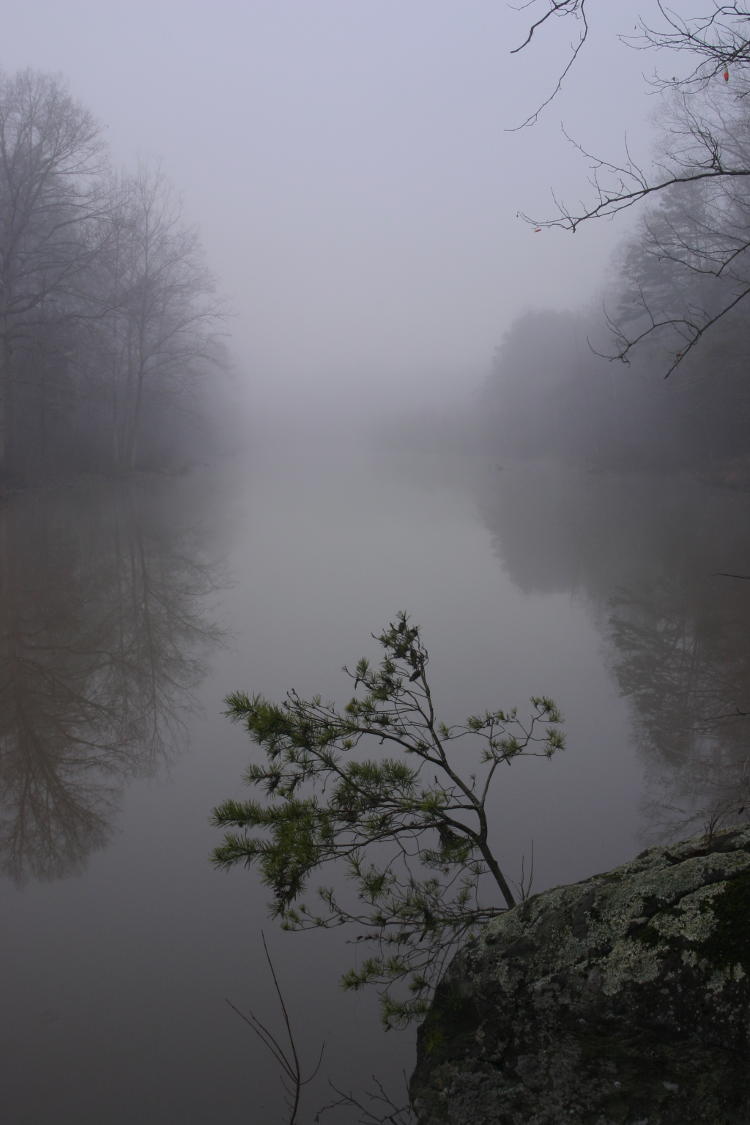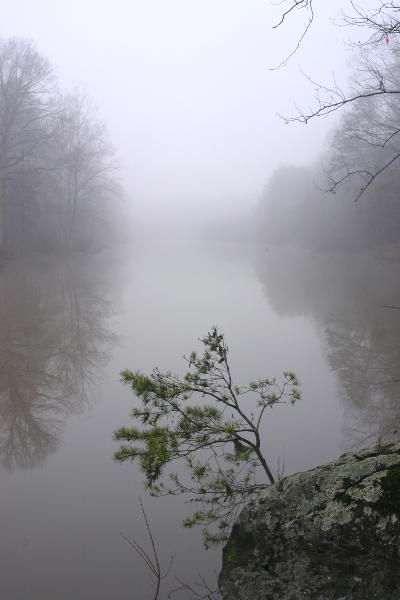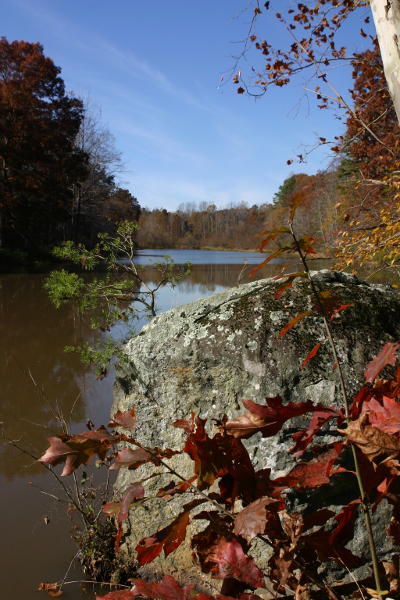
This week we jump back six years, when the day dawned wonderfully foggy and I scampered out to make the best of it. This was back at the old place, and the options were fairly thin there, especially in the narrow timeframe that fog often provides; you may have an hour, but often less, to do something with it, so finding a photogenic area better happen quick or the conditions will clear before you get there. In this case, there was a reservoir lake not too far away, very limited vantages but better than my immediate surroundings, so I rushed down there.
No herons, ducks, or other whatsits were providing any foreground interest, so I selected this evergreen sapling sprouting from a large boulder just offshore and framed it within the open space – it wasn’t elaborate, but hey, it was January, so I was lucky to have anything to shoot. I know, I know, after offering advice on what to do in the winter too, but it’s situations like this that fostered some of that advice in the first place, such as finding something nearby that worked with foggy conditions to keep in mind when such conditions arrived. I’d been looking out for photogenic lone trees in fields, old barns, old cemeteries, things along those lines, but had nothing within easy reach. Even the horse farms nearby, occasionally good for some figures in a field, were overnighting their livestock indoors in January.
 I’d left the exposure as normal to use the gloom, but it meant that what I captured was almost certainly a bit darker than what it actually looked like – the fog evened out both the sky and the reflections in the lake, so the meter read all of that and rendered it in mid-tones, that ol’ 18% grey that exposure meters are calibrated for. To the right is more likely what it actually looked like at 9 AM (though it’s merely the same image tweaked a bit brighter). It’s hard to describe this accurately, but bear with me. On a sunny day, the skies would have been brighter, but so would all of the rest of the frame, and the shutter speed would have shortened commensurately. Meanwhile, shadows would have been deeper, the distant trees themselves actually darker because they wouldn’t have been shrouded in fog, while the northern sky would have been blue, so the camera meter would have had a more average range to work with and would not have darkened the scene much, if at all, in attempting to expose for an average scene, as opposed to the largely light-grey scene that I had that morning. Make sense? Maybe it’d be better if I illustrate it more directly.
I’d left the exposure as normal to use the gloom, but it meant that what I captured was almost certainly a bit darker than what it actually looked like – the fog evened out both the sky and the reflections in the lake, so the meter read all of that and rendered it in mid-tones, that ol’ 18% grey that exposure meters are calibrated for. To the right is more likely what it actually looked like at 9 AM (though it’s merely the same image tweaked a bit brighter). It’s hard to describe this accurately, but bear with me. On a sunny day, the skies would have been brighter, but so would all of the rest of the frame, and the shutter speed would have shortened commensurately. Meanwhile, shadows would have been deeper, the distant trees themselves actually darker because they wouldn’t have been shrouded in fog, while the northern sky would have been blue, so the camera meter would have had a more average range to work with and would not have darkened the scene much, if at all, in attempting to expose for an average scene, as opposed to the largely light-grey scene that I had that morning. Make sense? Maybe it’d be better if I illustrate it more directly.
 Same location a little over two years earlier, slightly different shooting position (like I said, the available perspectives were few,) and a little more foliage. More colors, more difference between the brightest and darkest areas, or ‘dynamic range.’ While overall this scene is notably brighter (the difference in exposure from the original at top is 1.66 stops, not quite four times as bright,) the average light coming from all areas is closer to a good middle, rather than everything being medium bright grey in the fog shot because the fog even eliminated almost all of the darkest shadows. Had I included more of the sky-reflecting water in this frame, like above, the exposure would have changed a little because of the additional brightness, but bear in mind that water reflections are always darker than the original because of polarization, something visible even in both examples of the fog shot.
Same location a little over two years earlier, slightly different shooting position (like I said, the available perspectives were few,) and a little more foliage. More colors, more difference between the brightest and darkest areas, or ‘dynamic range.’ While overall this scene is notably brighter (the difference in exposure from the original at top is 1.66 stops, not quite four times as bright,) the average light coming from all areas is closer to a good middle, rather than everything being medium bright grey in the fog shot because the fog even eliminated almost all of the darkest shadows. Had I included more of the sky-reflecting water in this frame, like above, the exposure would have changed a little because of the additional brightness, but bear in mind that water reflections are always darker than the original because of polarization, something visible even in both examples of the fog shot.
One more thing to point out, for giggles: if you look closely at the overhanging tree close to my vantage, you’ll find fishing bobbers – they’re most visible in the larger image, but still here in the smaller daytime shot too. One of them is possibly the same in each. This is a common sight in any area that might appear to be good fishing; it seems the skill to cast a line away from overhanging trees isn’t well-developed in enough fisherfolk.
(And neither is the skill to take their fucking trash with them, but that’s a subject of another post.)



















































